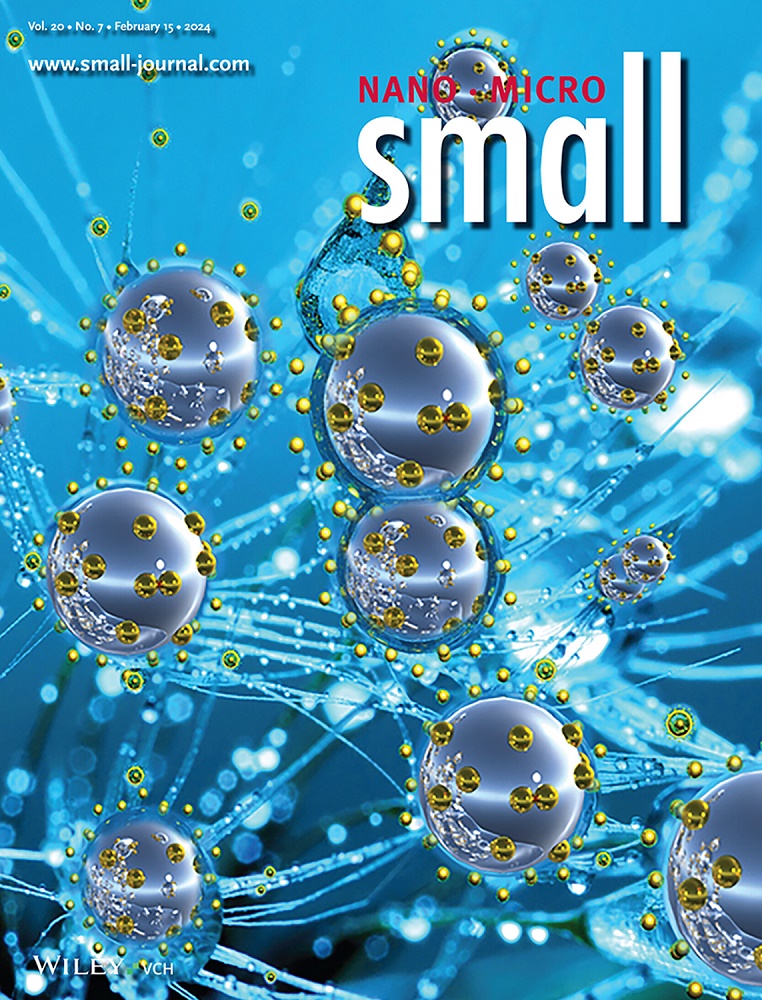在热激活延迟荧光聚硅氧烷中构建高效非掺杂柔性oled的阳离子-π相互作用。
IF 12.1
2区 材料科学
Q1 CHEMISTRY, MULTIDISCIPLINARY
引用次数: 0
摘要
高效热激活延迟荧光(TADF)聚合物由于其100%的激子利用率而成为溶液可加工电致发光器件的最佳选择之一。与以往碳-碳主链的TADF共聚物不同,本文创新性地将聚硅氧烷与TADF和宿主单元结合,制备了硅-氧主链的TADF聚合物。柔性聚硅氧烷链通过正电硅原子与TADF单元之间的阳离子-π相互作用而固化,从而减少了振动弛豫,从而使半最大全宽窄,具有较高的光致发光量子效率。因此,基于制备的均聚硅氧烷PSiBPA溶液处理的非掺杂oled在500 cd m-2下达到了27%的最大外量子效率(EQE)和20%的最大外量子效率(EQE),保持了迄今为止非掺杂聚合物器件的前沿。值得注意的是,PSiBPA是迄今为止唯一报道的高效均聚物。此外,PSiBPA还表现出优异的力学性能。因此,展示了弯曲半径为2mm的可弯曲oled的最大亮度和EQE几乎没有开始衰减。弯曲50次后,最大亮度和EQE仍可保持60%。该设计策略开发了一种通过阳离子-π相互作用优化TADF聚合物性能的新方法,用于构建高效的非掺杂柔性oled。本文章由计算机程序翻译,如有差异,请以英文原文为准。
Constructing Cation-π Interactions within Thermally Activated Delayed Fluorescence Polysiloxanes for High-Efficiency Non-Doped and Flexible OLEDs.
High-efficiency thermally activated delayed fluorescence (TADF) polymer is one of the excellent choices for solution-processable electroluminescent devices due to their 100% theoretical exciton utilization. Herein, different from the previous TADF copolymers with carbon-carbon main-chains, TADF polymers with silicon-oxygen main-chains are innovatively prepared by easily combing polysiloxanes with TADF and host units. The flexible polysiloxane chains are rigidified by the cation-π interaction between the electropositive silicon atoms and TADF units, resulting in reduced vibrational relaxation and thus the narrow full width at half maximum and high photoluminescence quantum efficiency. Consequently, solution-processed non-doped OLEDs based on the prepared homopolysiloxane PSiBPA reach a maximum external quantum efficiency (EQE) of 27% and EQE of 20% at 500 cd m-2, which keeps at the forefront of non-doped polymer devices to date. Noteworthily, PSiBPA is the only high-efficiency homopolymer reported so far. Furthermore, PSiBPA presents outstanding mechanical properties.Thus, bendable OLEDs that demonstrate the maximum brightness and EQE barely starting attenuation with a bending radius of 2 mm are showcased. Moreover, the maximum brightness and EQE can still maintain 60% after 50 bends. The design strategy develops a novel approach to optimizing the properties of TADF polymers via cation-π interactions for constructing high-efficiency non-doped and flexible OLEDs.
求助全文
通过发布文献求助,成功后即可免费获取论文全文。
去求助
来源期刊

Small
工程技术-材料科学:综合
CiteScore
17.70
自引率
3.80%
发文量
1830
审稿时长
2.1 months
期刊介绍:
Small serves as an exceptional platform for both experimental and theoretical studies in fundamental and applied interdisciplinary research at the nano- and microscale. The journal offers a compelling mix of peer-reviewed Research Articles, Reviews, Perspectives, and Comments.
With a remarkable 2022 Journal Impact Factor of 13.3 (Journal Citation Reports from Clarivate Analytics, 2023), Small remains among the top multidisciplinary journals, covering a wide range of topics at the interface of materials science, chemistry, physics, engineering, medicine, and biology.
Small's readership includes biochemists, biologists, biomedical scientists, chemists, engineers, information technologists, materials scientists, physicists, and theoreticians alike.
 求助内容:
求助内容: 应助结果提醒方式:
应助结果提醒方式:


